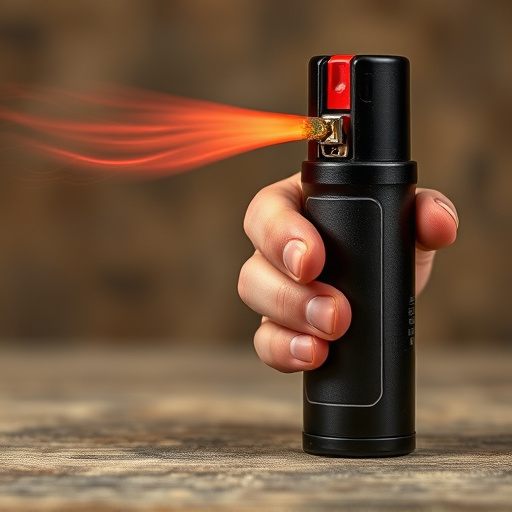Concealed pepper spray carrying techniques are vital for personal safety, empowering individuals to defend themselves in close-quarters encounters. To maximize effectiveness, choose compact, easily concealable units and train in proper application techniques focusing on target areas and distance. Strict adherence to local regulations, safe handling practices, and discretion is essential, ensuring readiness while maintaining secrecy.
Personal safety is paramount, especially in today’s unpredictable world. One powerful tool that can provide a decisive advantage is concealed pepper spray. This article guides you through the essentials of carrying and using this potent self-defense mechanism discreetly. From understanding its mechanics and legal permissions to mastering concealment techniques and safety best practices, discover the art of protecting yourself effectively. Learn the carrying techniques to ensure maximum discretion while adhering to legal considerations.
- Understanding Pepper Spray: Its Power and Limitations
- Legal Considerations for Carrying Concealed Pepper Spray
- Effective Concealment Techniques for Maximum Discretion
- Safety Tips and Best Practices for Responsible Use
Understanding Pepper Spray: Its Power and Limitations
Pepper spray, a powerful self-defense tool, has become an essential addition to personal safety kits. It works by causing temporary blindness, coughing, and difficulty breathing through the irritation of the eyes and respiratory system. This disruption allows users to escape potentially harmful situations. However, it’s crucial to understand its limitations. Pepper spray is most effective in close-quarters combat, often requiring a direct blast into the face. Wind or rain can significantly reduce its effectiveness as the spray can be blown away or washed off.
When considering concealed pepper spray carrying techniques, understanding these limitations is vital for optimal use. It’s important to choose a compact, easily concealable unit designed for discreet carry. Training in proper application techniques, including target areas and distance, ensures maximum impact when needed.
Legal Considerations for Carrying Concealed Pepper Spray
When considering carrying concealed pepper spray for personal safety, it’s crucial to understand the legal framework surrounding its possession and use varies significantly across jurisdictions. What is legally permissible in one region might be strictly regulated or even illegal in another. Before deploying this self-defense tool, individuals must familiarize themselves with local laws and regulations. This includes understanding the types of pepper spray allowed, the quantity limits, and any restrictions on where and how it can be carried.
Concealed pepper spray carrying techniques play a vital role in ensuring its effective use while adhering to legal boundaries. Different states and provinces may have specific rules about permit requirements, registration, and even the type of container permitted for storage. Some areas might allow only specialized law enforcement or security personnel to carry pepper spray, while others may offer concealed carry permits under certain conditions. Individuals must stay informed and follow these regulations strictly to avoid legal repercussions and ensure their safety.
Effective Concealment Techniques for Maximum Discretion
When it comes to personal safety, discretion is key. One of the most effective ways to ensure your pepper spray remains a secret tool is through clever concealment techniques. Start by choosing a small, compact can that blends in with everyday items. Consider carrying it in a purse, backpack, or even a fanny pack – places where it would be out of sight and reach for casual onlookers.
For an extra layer of discretion, utilize hidden compartments or hollowed-out objects. For instance, a small, stylish clutch bag designed with a secret compartment can easily house your pepper spray while still looking fashionable. Alternatively, consider holstering the spray in a custom-made pouch attached to your belt loop, ensuring it’s readily accessible yet concealed from casual view.
Safety Tips and Best Practices for Responsible Use
When carrying concealed pepper spray, understanding safe handling practices is paramount. Always ensure the canister is secure and inaccessible to children or unauthorized individuals. Regularly inspect the spray for any signs of damage or leakage, and check the expiration date to guarantee its potency. Familiarize yourself with local laws regarding pepper spray ownership and use; adhere strictly to these regulations to avoid legal repercussions.
Best practices involve keeping the spray in an easily accessible yet discreet location, such as a belt pouch or inside your clothing. Practice aiming techniques regularly to ensure accuracy during an emergency. Remember, pepper spray is a powerful tool meant for self-defense only; its use should be a last resort when facing imminent physical harm.
Carrying concealed pepper spray can be a valuable personal safety measure, but it requires understanding both its power and limitations. With knowledge of legal considerations and effective concealment techniques, individuals can exercise discretion while ensuring maximum protection. Following safe practices and best behaviors for responsible use is paramount to effectively deterring potential threats and maintaining control in threatening situations.
